Lack of Tritium Fuel Supply
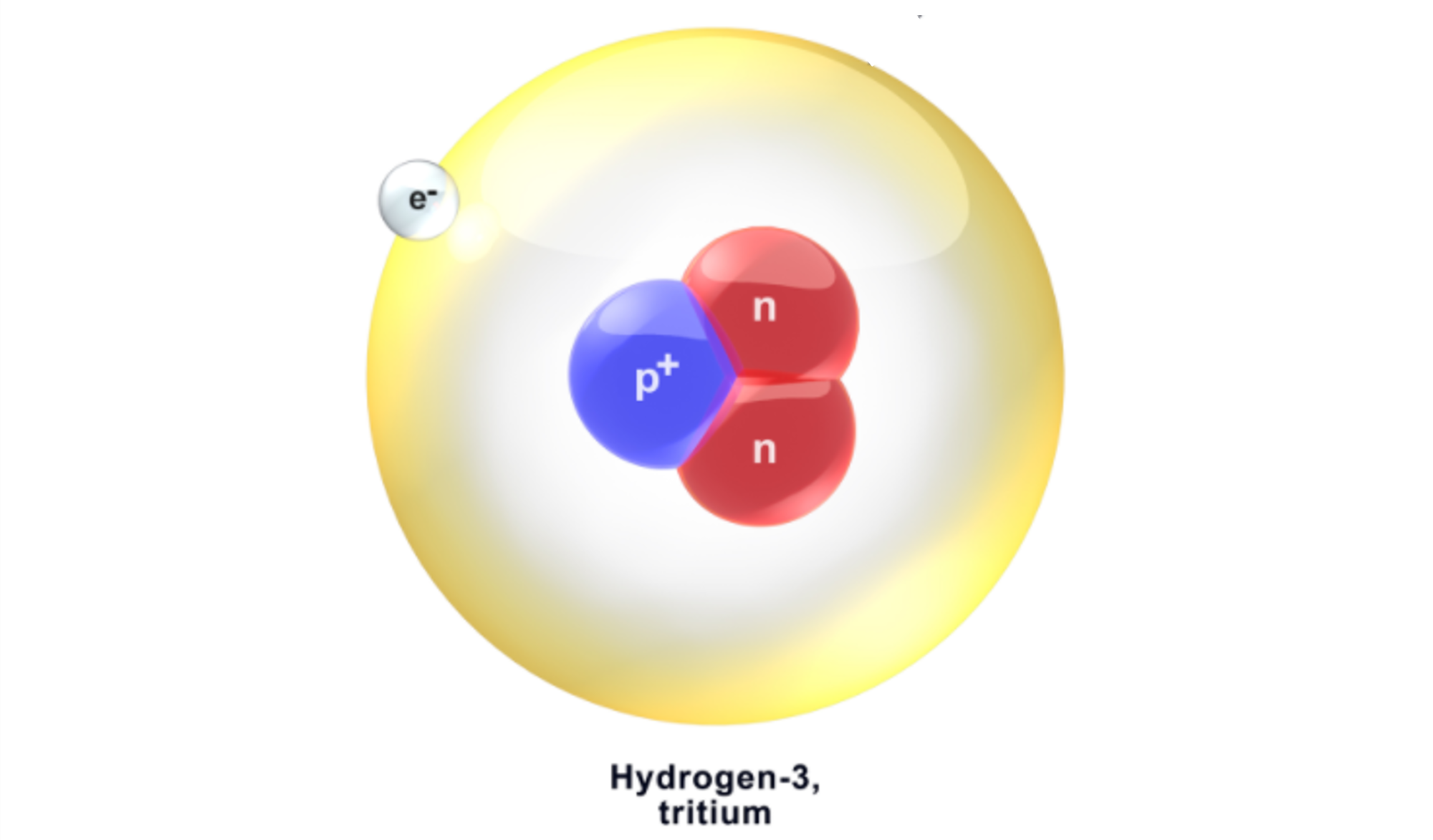
The supply of tritium fuel is an enormous problem for mainstream fusion power plants, probably a show-stopper. Surprisingly, fusion advocates often say that the fuel is abundant and an advantage of fusion. In reality, the opposite is the case for tritium and propaganda on this issue contains much misinformation as described in the references at the bottom of this pages. A single fusion power plant, with electrical power output 1 GigaWatt, would consume about 60 kg/year of tritium but, currently, only about 0.5 kg/year is produced worldwide, in fact from nuclear nuclear fission reactors.
The most viable way to produce tritium fuel for fusion reactors, both in the present and in the future, seems to be from fission reactors, making it impossible for fusion ever to replace fission.
Natural sources of tritium
A misleading feature of propaganda from fusion advocates are statements that the fuel is abundant in the sea. However, in all the oceans of the world there is only about 30 kg of tritium.
The figure below, from the paper by Ohms et al., shows the distribution of tritium in the world's oceans in tritiated water molecules, hydrogen tritium oxide (HTO). The concentration is highest in the northern hemisphere because the main source is the atmospheric nuclear tests in the 1950s and 1960s. About 10% of the tritium in the sea is constantly replenished from generation by cosmic rays interactions in the atmosphere.
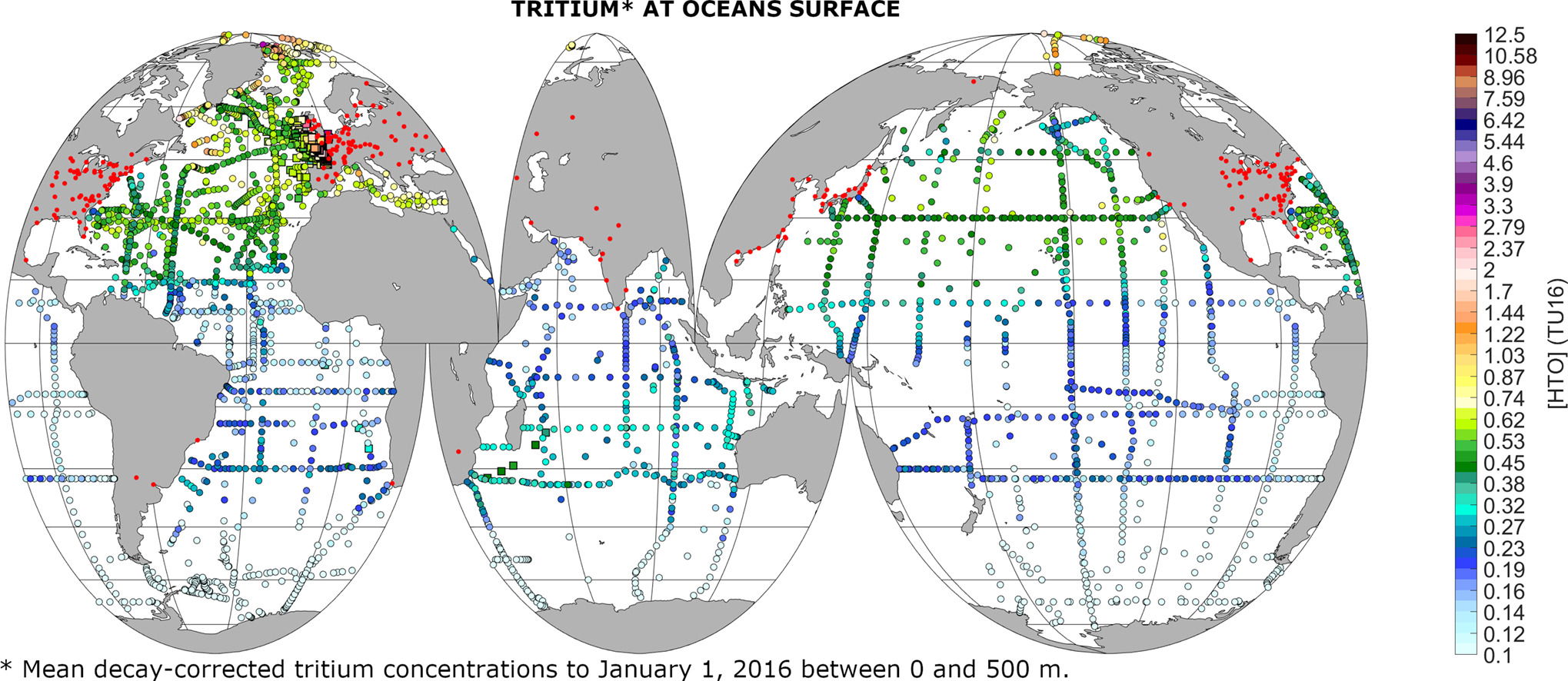
Mean tritium concentrations measured in the oceans between 0 and 500 m depth. The coloured circles in the oceans are the locations where tritium measurements were recorded and the red circles on land indicate the locations of nuclear fission power plants. The unit are TU16, meaning tritium units corrected for decay to 2016, where 1 TU is 1 tritium atom per 1018 hydrogen atoms.
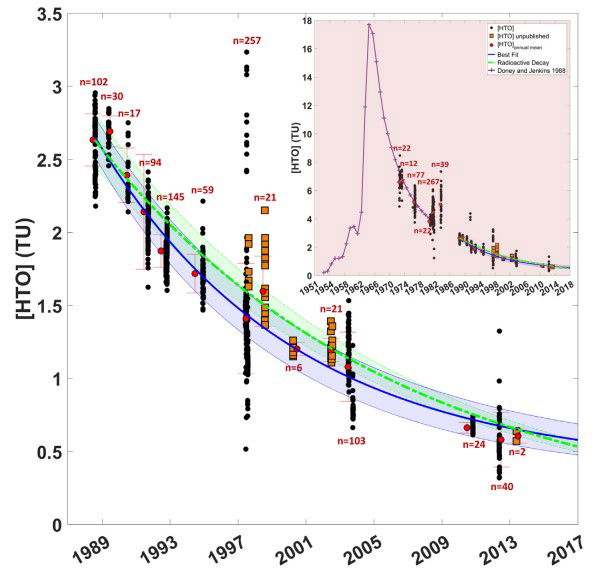
Decay of tritium levels in measurements from a wide area in the North Atlantic.
The decay of tritium with a half-life of 12.3 years (5% per year), indicated in the plot above for the tritium in the oceans, is a major problem for all sources of tritium.
A claim on the website of the private Commonwealth Fusion Systems (CFS), states that "One glass of water will provide enough fusion fuel for one person's lifetime". The data above shows that one glass of water taken from the sea offshore from Boston would contain 3 million tritium atoms which is enough to heat the glass of water by fusion reactions by 0.0004°C. This propaganda claim of CFS is clearly wrong and similar statements in many other communications from fusion advocates are deliberately misleading.
No tritium is commercially extracted from the sea and all commercial supplies come from fission reactors, largely CANDU fission reactors which have heavy water as moderator. The current world stock of tritium is around 25kg which will increase slowly until the CANDU reactors reach the end of their operational lives. From then on, the radioactive tritium will decay away at a rate of 5% per year. When the ITER prototype fusion reactor starts fusion operations after 2035, it will consume the major fraction of the world stock. The figure below shows an estimated evolution of the world stock of tritium.
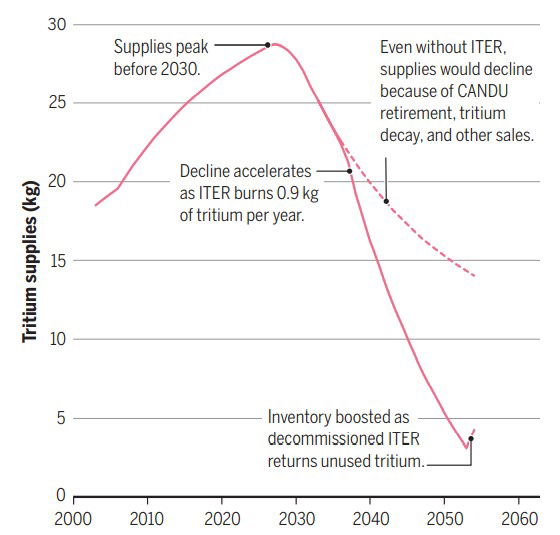
Projection of world civil tritium supplies in coming decades.
Tritium supplies for fusion power plants
Due to the limitations of external supply, fusion reactors must regenerate tritium. This process involves three separate aspects, all very difficult to achieve:
- Initial start-up inventory
- Tritium breeding
- Reactor tritium fuel cycle
Two of these aspects are covered on this page. The aspect of tritium breeding is covered in the page: Breeder Blanket where possible values for the Tritium Breeding Ratio (TBR) are given.
Initial start-up inventory
According to the estimates described above, by 2050 when the construction of the first fusion power plants might start, world tritium stock could be less than a few kg. Even if the tritium breeding process actually works in practice, an initial start-up inventory for each reactor is required.
The paper by Kovari et al., explores various options to start-up commercial fusion reactors. In theory, a lack of tritium could be overcome at any time, since it can be generated in a fission reactor, but any claimed advantages of replacing fission with fusion clearly are not valid if fission reactors must be built to supply the fusion fuel.
The Kovari paper considers scenarios with less than 50% tritium at start-up, which amount to using deuterium-deuterium fusion to internally generate tritium. In the fusion reactor considered in the paper, the table below gives the fusion power for various tritium %.
| Tritium % | Fusion power (MW) | DT fusion rate (s−1) | DD fusion rate (s−1) |
| 1 | 40 | 1.3 1019 | 1.1 1019 |
| 5 | 200 | 7.4 1019 | 1.3 1019 |
| 10 | 500 | 1.8 1020 | 1.4 1019 |
| 25 | 1500 | 5.2 1020 | 1.3 1019 |
| 50 | 2400 | 8.5 1020 | 8.4 1018 |
Start-up with deuterium rich fuel. Fusion power and rates of DT and DD reactions are shown for different initial tritium percentages.
The figure below shows the elapsed time required for a given starting tritium inventory. Starting up at 1% tritium in the plasma (61g inventory) the plant needs to be operated for 7 elapsed years before reaching 50% tritium operation. Starting up at 10% (830 g inventory) needs 4 elapsed years.
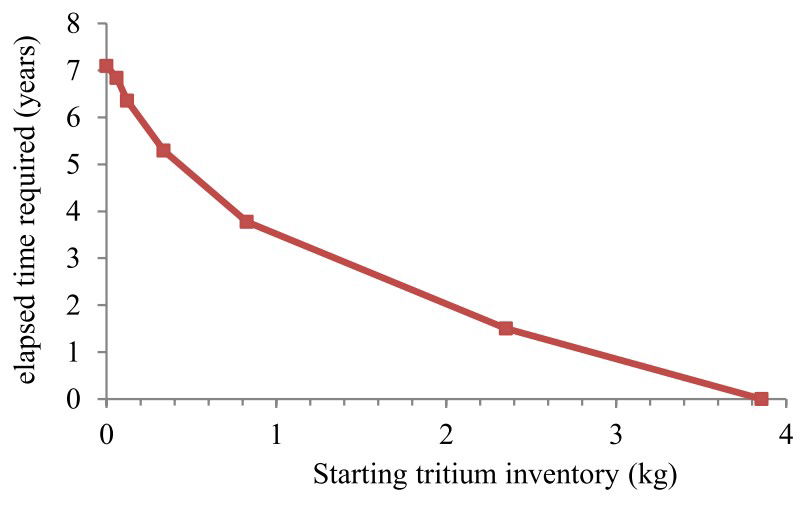
In the Kovari et al. scenarios of breeding tritium from deuterium-deuterium reactions, the time to reach 50% tritium percentage with different starting tritium inventory.
The Kovari paper concludes that all of the alternative production methods considered have serious economic and regulatory drawbacks.
Reactor tritium fuel cycle
If somehow a start-up inventory is obtained, in the tritium fuel cycle in a fusion reactor it would be very difficult to maintain or increase the tritium stock.
After injection into the reactor only a few percent of the tritium is actually burnt. The un-burnt fuel must be recuperated, purified and re-injected. The regeneration of tritium in the breeder blanket is extremely complicated. The figure below, from the paper: Abdou et al. (2021), illustrates the complexities in the tritium fuel cycle.
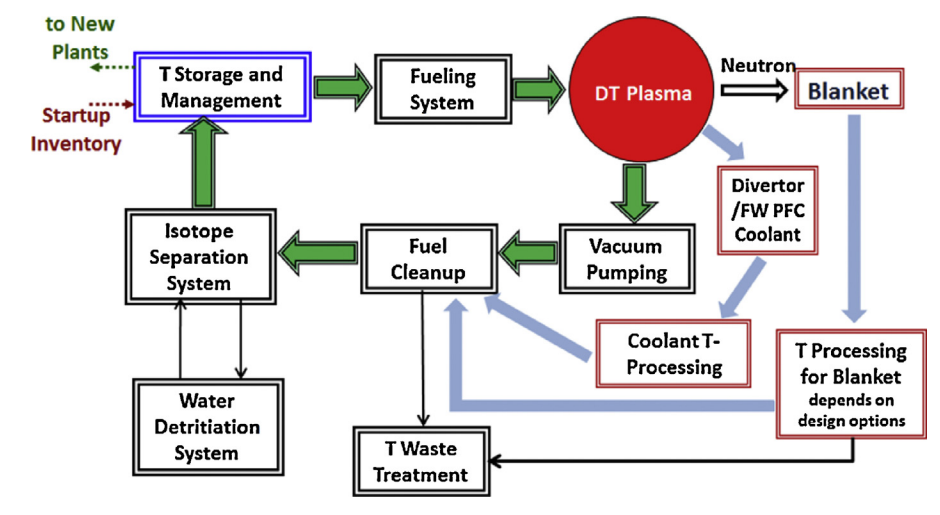
Tritium fuel cycle of a fusion reactor. Tritium injected into plasma but not burnt, passes into an exhaust or is trapped on divertor, the first wall (FW) and other plasma facing components (PFC). Neutrons from fusion interact in the blanket and regenerate tritium.
The tritium fuel cycle illustrated in this diagram has two sub-cycles as follows.
- Inner Fuel Cycle (IFC): plasma exhaust (vacuum pump), fuel clean-up, isotope separation, water detritiation, storage and management, and fueling systems.
- Outer Fuel Cycle (OFC): first wall, divertor, breeding zone (BZ), coolant processing and tritium extraction system.
Abdou et al. have developed a dynamic model to evaluate the requirement to achieve tritium self-sufficiency. The model considers several parameters, including:
- Tritium burn fraction in the plasma (fb)
- Fuelling efficiency (ηf)
- Time required for tritium processing of various tritium-containing streams (tp)
- Availability factor (AF)
As an example of the analysis in the paper, the figure below shows the required Tritium Breeding Ratio (TBR) for various tritium processing time, tp , in the plasma exhaust, as a function of ηf fb.

Required TBR as a function of the product of TBF and fueling efficiency for various tritium processing times in the plasma exhaust of the IFC (1, 4, and 12 h) and availability factor of 50%.
The estimates of TBR possible with existing technologies are in the range 1.05 - 1.15 and indicated by the green bands in the plot. The conclusion of Abdou et al. is that with the parameters as in the ITER design, tritium self-sufficiency is not possible.
Conclusion on tritium fuel
The papers discussed in this section illustrate that:
- tritium is not available in the natural environment,
- obtaining start-up tritium from initial deuterium-deuterium reactors in a fusion reactor would not be economic,
- breeding tritium in a fusion reactor is very difficult and has never been tested,
- obtaining tritium from fission reactors is the current source, and would be the most economical future source for fusion reactors.
The last point of obtaining tritium for fusion reactors from fission reactors would seem to be a major dichotomy when the motivation for fusion is usually given as replacing fission.
These conclusions are covered in more detail in the following references.
- A series of articles on the website of Steven Krivit at: The New Energy Times, Fusion Fuel Exposé, gives examples of the propaganda used to mislead the general public on the tritium supply situation.
- An excellent treatment of the supply issue of tritium, as well as lithium and other rare minerals for use in a fusion reactor, is given in the book of L.J. Reinders, The Fairy Tale of Nuclear Fusion.
- There is an excellent article by Daniel Clery in Science: Fusion power may run out of fuel before it even gets started.
Alternative fuels?
Without tritium fuel, the question arises as whether alternative fuels are possible. The alternatives are considered in the page: Alternative Approaches with the conclusion they are also, in practice, not possible.